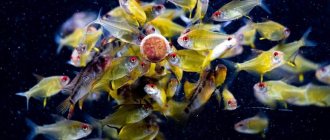Angelfish are popular fish that can be immediately recognized by their beautiful, crescent-shaped body. The fish are brightly colored and do not require complex care, which has made them the favorite abode of aquarists of all levels. Many aquarists breed angelfish at home, but do not know how to do it and where to start. Breeding angelfish at home requires a lot of time and labor. To breed offspring at home, you need to create optimal conditions for the fish, monitor the eggs and prepare a separate tank. But first things first.
Spawning tank
Before you start breeding, you need to create a special space - a spawning area. It is best to set aside a separate aquarium for it, but if this is not possible, then use a fenced-off space in a common tank. Peculiarities:
A spawning tank for angelfish is a medium-sized aquarium, about half filled. Without soil, with surfaces for masonry, and the necessary equipment: filter, heater, aerator, light.
The spawning container is created in advance. It is necessary both for the safety of the offspring and for the peace of mind of the couple (there is no need to constantly drive away other fish). In the spawning tank, it is advisable to plant vegetation with strong leaves, place a plastic object or a small container - this will serve as a place for laying eggs (in natural conditions, fish look for a flat and dense surface). After mating, the parents take care of the eggs, but in a stressful situation they can eat the eggs, so sometimes the owner takes care of the eggs, and the parents of their spawning fish are evicted into a common aquarium.
The relocated fish will begin to independently prepare a space for laying eggs.
Caring for fry
The shells of the eggs rupture after a couple of days, turning into ropes on which the larvae hang. After 4 days, you can already see the heads and yolk sacs from which the larvae receive food. They move constantly, trying to free themselves.
After a week or two, the fry gain freedom. Now they need feeding. To do this, it is necessary to prepare in advance live food for the fry: daphnia, ciliates, and artemia. Babies need to be fed 5-6 times a day. In addition, you need to place a filter in the incubator, covered with a nylon stocking for safety. The density of fry should be about 2 pieces. per liter of water. If there are more of them, then you need to put them in another aquarium. Before one feeding, change a third of the water, removing the remaining food beforehand.
After 30-45 days, small angelfish acquire a characteristic shape, after which they need to be seated with a density of 4-5 liters of water per fry. Fish of this age are fed small bloodworms, live food, and chopped tubifex. Very soon you can move the fry to a regular aquarium for this species.
Incubation
The incubator can be a small aquarium or even a plastic food tray with a volume of 7-10 liters. Before starting, it is washed thoroughly; soda can be used as a detergent. The water is taken half from the parent aquarium, half purified by reverse osmosis. Before placing caviar in it, the temperature in the container should be raised to 29-30 C (Tetratec HT 25). Aeration should be quite intense, but slightly away from the eggs. Well, and most importantly, you need to protect the eggs from fungal attack. To do this, you can use a freshly prepared aqueous solution of methylene blue. It is better not to pour the crystals themselves into the container - dilute them separately in a small volume and gradually add them until a deep blue color is obtained, but without loss of transparency. Or you can use a fungicide like Sera mycopur.
Live caviar is translucent. It is advisable to choose white eggs. Especially if they touch normal ones. It happens that all the eggs turn white a few hours after spawning. If the incubation conditions are met, then the issue is with the producers. The pair may be young or old, weakened, or a sterile male. It very rarely happens that two females begin to spawn in the absence of a male - such eggs remain unfertilized. But the most common reason is the youth of the producers. It is better not to take the first 2-3 clutches.
After approximately 2 days (at lower temperatures the process is delayed) larvae appear. At this time, it is advisable to remove the sheet with the missing eggs, shaking off the living larvae from it. They immediately stick together in “garlands” without ceasing to twitch their tails. It is also better to remove whitened caviar from the bottom, at least partially. A third of the water can be replaced with the same composition and temperature, only without the blue. Over the next 5 days, the larvae will develop, gradually turning into fry.
Spawning
Sexual maturity of angelfish occurs at 6–12 months and depends on the conditions of detention, breed and health of the fish. Females spawn on leaves, soil, and sometimes on the surface of the filter.
Preparation
Create good conditions for future offspring. You will need containers for spawning and keeping fry. A week before spawning, feed the future parents with protein and high-quality food:
- bloodworm;
- tubifex;
- culex;
- coretra;
- specialized feeds.
Process
The readiness of angelfish for spawning can be determined by the rounded abdomen of the female and the aggressive attitude of the couple towards other inhabitants. The fish drive their neighbors away from their designated spawning site. Place the pair in a prepared aquarium with similar water parameters. The female lays 100–500 eggs, which are later fertilized by the male. After spawning, they care for the clutch until the fry appear. The parents fan the eggs with their fins, removing unfertilized ones from the clutch.
Manufacturers' choice
Successful propagation of angelfish at home depends on how the preparatory stage goes. The aquarium owner must take into account a number of features of the upcoming process:
- it is necessary to create suitable conditions for the deposition of eggs (microclimate);
- it is necessary to place separate containers for spawning fish and young fish;
- choose the right breeders - the individuals must be healthy and brightly colored.
For breeding you need to choose the most beautiful pair.
After selecting suitable representatives, it is recommended to prepare for breeding. It begins 7-8 days before the planned spawning. During this period, the parents should receive protein-enriched food. Specialized ready-made food, bloodworms, tubifex or culex (mosquito) are best suited for this. Males and females should be kept together.
Angelfish are sensitive to water temperature. It should not fall below 27 degrees.
Sex differences
Differences or dimorphism in fish of this species are weakly expressed. Distinctive features that are present in females:
- there is no fatty lump on the head;
- the sizes are relatively small;
- front fins single;
- The ovipositor is obtuse in shape.
Males have a pointed genital organ. They are larger. The main visual feature is the presence of a large and well-defined forehead (due to the presence of a fatty lump).
Sexual dimorphism of angelfish is not clearly expressed, but with a little experience you can easily cope with this task.
Sexual characteristics can be distinguished in fish that are more than 1 year old, since by this time the maturation period will have passed. It is easier to determine sex in standard representatives of the species.
Life of schooling fish
Some types of aquarium fish, for example, almost all bottom-dwelling catfish, feel great alone. With angelfish, everything is not so simple; in nature, they are schooling fish, living in groups of 10–15 individuals. And even long-term domestication could not change this habit: representatives of this species feel good only in a group.
Experienced aquarists advise choosing a dozen small angelfish with wide and long fins. Then, as they grow older, the fish themselves will split into pairs. Usually in an aquarium there is one dominant pair of angelfish, the largest and with a good appetite. The rest of the fish will stay away.
Most likely, it is this dominant pair that will lay angelfish eggs in the aquarium. Although, if the aquarium is large enough and has a lot of plants for cover, other fish will also have a chance to reproduce.
Step by step
- Prepare a spawning tank of 100 liters with settled water. Adjust water temperature and settings. Provide a place to lay the eggs, such as a sponge or spawning cone.
- Wait for the angelfish to form pairs.
- Place the pair in the breeding aquarium.
- If the couple eats the eggs, raise them artificially. Transfer the eggs to a clean jar. Treat the water with a fungicide, then acriflavine, and provide oxygen. The temperature should be 27 degrees.
- The next day, carefully remove the white eggs with tweezers.
- The fry will hatch in 60 hours. Start feeding 5-6 days after hatching.
- Transfer the fry to a larger aquarium when they begin to swim in a school.
Breeding angelfish is a process that is interesting to watch. The first successful attempt at breeding fish occurred in 1914. Since then, aquarists have learned to breed angelfish at home.
Previous FishIs it possible to have a fish like a blue dolphin in an aquarium? Next
FishThe whole truth about the parrot fish
In fact
Although parental care is extremely important for the development of small fish, adult fish do not provide as much care. Even if you place the selected pair in a separate aquarium, there will be no guarantee that the parents will care for the eggs. This is especially true for young individuals.
And angelfish (fry) simply have no chance of hatching from eggs in a community aquarium without outside help. At best, the couple will try to protect the eggs for the first two days. But the stress from spawning and the interference of voracious neighbors leads to the fact that some of the offspring will be eaten and the rest will disappear.
It happens that when darkness falls, the parents themselves get lost and eat the recently laid eggs.
There are several options for what to do with angelfish eggs in a community aquarium. You can leave everything as is, then the pets will receive an additional portion of food, and the pair will be ready for the next spawning in about a month.
And those who set out to raise a school of small fish have two options: place the parents together with the eggs, or equip a small aquarium and turn into a nanny for a while.
Meat supplement
Along with dry and frozen food, it is useful to diversify the fish menu with beef heart shavings. To do this, you need to trim off the fat, wash it thoroughly and cut it into small pieces. They are taken out of the refrigerator, grated on a fine grater, and rinsed in a strainer to get rid of blood and small particles that the angelfish does not eat, pouncing on large pieces. Food is served warm.
Minced meat is also a nutritious organic food, which, in addition to beef heart, includes several other components useful for fish:
- dry pharmaceutical nettle;
- cabbage leaves;
- Bell pepper;
- seafood (squid, mussels, octopus and shrimp).
For 100 grams of meat, take the same amount of additional components in equal parts, grind all products in a meat grinder or blender, mix well, add 1 raw egg to the mixture. Then a pancake is formed, which is baked in the microwave for 1-2 minutes. After cooling, it should be placed in the freezer.
An indicator of normal freezing is food crumbling into small pieces. This is important, since large pieces of angelfish may choke, or even not eat them at all.
By the way, these ingredients can be replaced with others: meat and seafood - fillet of sea fish, pepper and cabbage - zucchini, grains of canned corn or green peas.
When it comes to food, the angelfish can be extremely picky – it can spit out what it doesn’t like. It is especially difficult to accustom her to new dishes. Experienced aquarists recommend repeating attempts and offering unfamiliar food to the fish - after fasting for several days, it will still begin to eat the food offered.
Fry
After 2–3 days, the larvae hatch from the eggs.
At first, they are weak and immobile; they require special maintenance.
Conditions of care
- Only 2 liters of the aquarium volume is enough for the fry that hatched from the eggs. For a month-old fry there must be at least 4 liters of water volume. As they grow, plant the young ones. Lack of space leads to improper development.
- Juveniles are very sensitive to water purity. Change one third of the fluid daily.
- It is important to choose a filter that will not suck the fry into. Cover the bottom of the filter with nylon.
Development
The fry stage occurs in 6–12 days. At the age of a month, the fry acquire the features of adults and a more complex structure.
Feeding
When the fry's egg sac dissolves, they begin to feed. They eat 5-6 times a day. Suitable for feeding fry:
- ciliates;
- nauplii;
- Artemia;
- egg yolk;
- daphnia;
- Cyclops;
- small bloodworm.
Variety of angelfish breeding experiences
Breeding angelfish at home does not always work the first time. Many aquarists have gone through failures and mistakes before they were able to raise fry to beautiful adult fish. By carefully studying the experience of others, you can understand what consistent actions need to be taken in order for scalar breeding to be successful. There are different ways.
The experience of the first aquarist
In the first experiment, breeding angelfish in a community aquarium is not practiced. An aquarium with a volume of 150 liters is prepared in advance: there are no decorations, inside there are only a heater, filter sponges and two small pieces of PVC pipe (2 inches). The water temperature is maintained close to 27 degrees, neutral pH (7) and hardness – 2.
The first stage of preparation for spawning
“Minor” angelfish in the amount of six individuals are transplanted into the aquarium prepared in this way. At this time, bloodworms, frozen brine shrimp, flakes, ground beef heart and white worms (only occasionally) are offered as food.
Having reached sexual maturity, the fish begin to search for a mate. At this time, you need to be very careful and observe the behavior of the angelfish. The resulting pairs are clearly visible: they stay close, “be nice” to each other, and drive other fish away from the chosen territory. Such a couple must be placed in a smaller aquarium (about 80 liters with the parameters indicated above) so that they remain alone.
The second stage of preparation for spawning
In this spawning area you will watch how angelfish reproduce. Since the angelfish will directly spawn here, it is necessary to place a suitable substrate for attachment of the laid eggs. These can be pieces of PVC pipes or clay pots.
To stimulate the maturation of reproductive products, it is recommended:
- slowly increase the water in the spawning tank to 28 degrees;
- increase the food rations of producers.
After approximately one week (possibly after 5 days), it is already possible to identify the female by her enlarged belly. A few more days will pass, and the future parents will develop genital papillae. Now you can clearly see how to distinguish a female from a male angelfish. The structural features of the papillae of males and females were discussed above.
Observations of egg laying
The aquarist needs to carefully observe how angelfish reproduce, but nothing more: as soon as the process of laying eggs begins, it is not recommended to climb into the aquarium and disturb the fish.
It is necessary to remember which of the fish laid eggs. It is also important to ensure that the male fertilizes her. In two days you will find out if your couple is fertile. Sometimes the eggs turn white and die. This means that fertilization has not occurred. Successful spawning of a pair may not happen on the first try.
Natural egg incubation
Breeding angelfish using the described technology is recommended by natural incubation of eggs. The parents do not move away after spawning. They care for the eggs, making fanning movements with their fins, ensuring the constant presence of fresh water near the eggs. When the larvae hatch from the eggs, the parents help them free themselves from the egg shell.
After the larvae hatch from the eggs, the courtship process continues. About 10 days will pass, and the fry will swim freely around the aquarium. At this time, it is recommended to start feeding them brine shrimp and microworms.
Let the parents stay with their babies for a few more days and then transfer them to another aquarium. From this point on, adult angelfish are ready for the next breeding cycle. When using the above technology, female angelfish will become pregnant regularly at intervals of 10-20 days.
Remember two important points:
- Death of fry occurs even in extremely favorable conditions (death rate of approximately 20 percent).
- It is not recommended to frequently create conditions for spawning of adult angelfish. Give them a “vacation” between spawnings.
Experience of a second aquarist
You can find a lot of different information about how angelfish reproduce, because there is no uniform method for breeding these wonderful fish. Let's get acquainted with the experience of another aquarist who practices breeding angelfish in a community aquarium. After considering and analyzing different methods, you will choose the one that is most convenient for you.
Stimulation
In order for breeding to be successful, it is necessary to stimulate the created pair. It is recommended to create optimal conditions - the water in the aquarium should be on average 30 degrees, the amount of light should be large (the duration of the light period is at least 10 hours a day). It is necessary to fence off the space where spawning will take place so that other fish do not swim too close. If stimulation for reproduction is successful, the female will lay about 150 eggs . They will then be fertilized by the male.
15:22
Breeding Angelfish from A to Z.
For successful reproduction of fish of the angelfish species, feeding and housing conditions must be observed immediately before the process of laying eggs.
In the process of stimulating the process, it must be taken into account that the temperature of the water should always be stable. Changes in values will negatively affect the survival of fry and the viability of eggs.
A gradual increase in water temperature from 27 degrees to 30 will help initiate spawning.
Additional recommendations:
- you need to carry out a gradual water change (updated to 10% of the volume 4 times a week).
- feeding is plentiful (bloodworms are the basis of the diet);
- You need to think about breeding at home when the fish is 6 months old - during this period the species begins to reach sexual maturity. The optimal period is 12 months.
The process of fertilization by males takes place only in the presence of a female, so there is no need to resettle them.
If you feed the fish only dry food, then in 90% of cases you will not be able to get offspring from it.
Whitened eggs are unfertilized; they will soon begin to deteriorate and can poison neighboring eggs with decay products.
It is also recommended to remove the eggs in a timely manner. In this way, you can increase the number of spawnings per season. If favorable conditions are created, the process will be repeated once a month.











